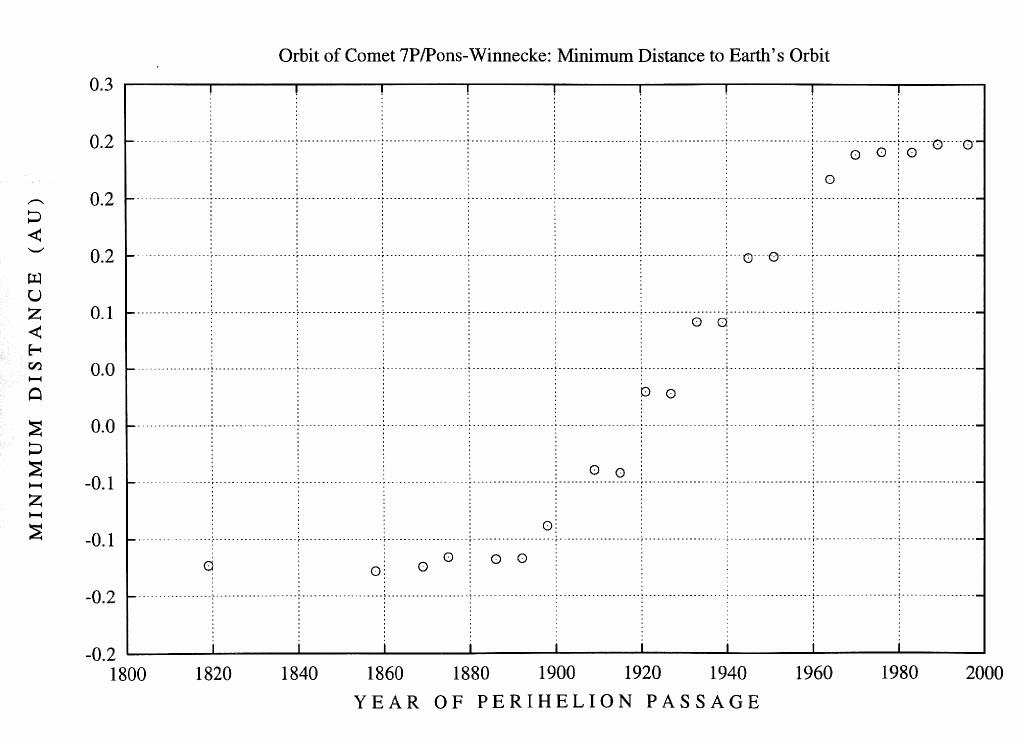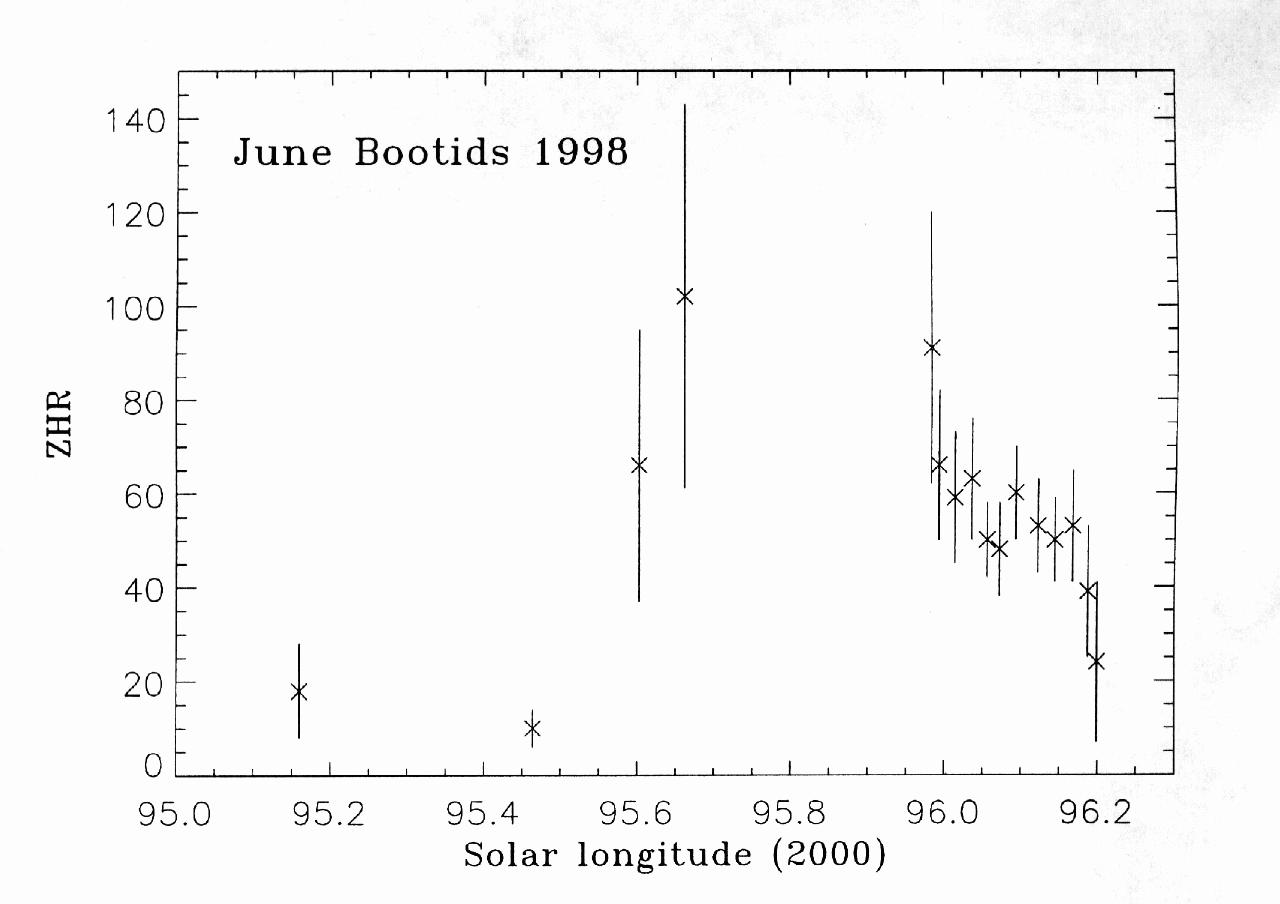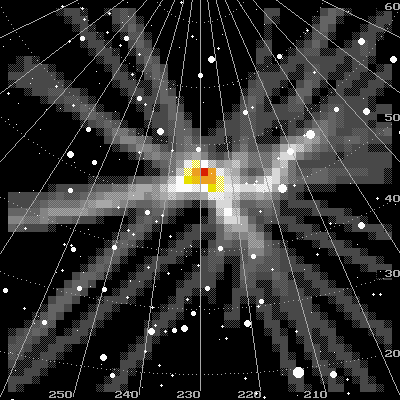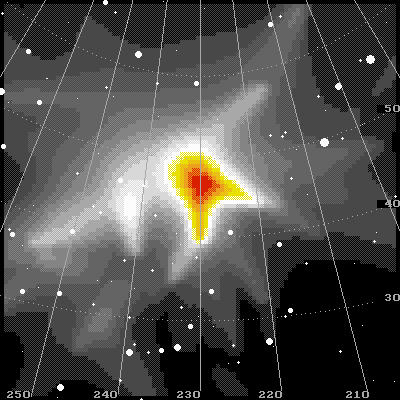
June Bootids 1998 / Juni Bootiden 1998

Surprising Activity of the June Bootids 1998
Jürgen Rendtel, Rainer Arlt, Valentin Velkov
Introduction
Considerable activity of the June-Bootids was observed at two
occasions in 1916 and 1927. Some sources also list the year 1921,
but the activity reported from this return is rather low (see
Table 1). Additionally, there are some reports of possible
activity before and after these returns, but the association to
the June-Bootids is not certain. Nevertheless, Hoffmeister (1948)
considered the shower (listed as June-Draconids on p. 88) as a
``real shower'' which was excluded from his final catalogue only
because of insufficient observation. When the current IMO
working list of meteor showers was established, the shower was
rejected because its regular activity was practically below the
detection limits for many years. However, June is a period of the
year which is poorly covered by meteor observations generally, and
in particular from the northern hemisphere.
Previous observations of the June Bootids
First, we give a summary of old observations of the June-Bootids
regarding their activity. We restrict to those returns where
a considerable rate was reported from several locations. Most
observers made plots, even when high rates were present. During
the 1927 return, plots and counts were made by different observers
of the Tashkent group (Sytinsky, 1928). Please note that there
are no data for further reduction, such as the limiting
magnitude. The data are also diffcult to compare with
one another.
Table 1: Activity of the June Bootids during the 1916, 1921 and
1927 returns of the shower which is to be found in the literature.
Rates do not refer to the term ZHR which is in use now, but give
only numbers per hour independent on the observing conditions.
Other papers just give numbers of shower meteors noted by the
observer.
--------------------------------------------------------------------------------------
Date/Time Activity Observer Source
(UT) and remarks
--------------------------------------------------------------------------------------
1860 and 1861
Jun 30 ``many'' Lowe Denning (1916)
--------------------------------------------------------------------------------------
1916
Jun 28 2225--0010 55 met. Denning Denning (1916)
Jun 29 0045--0115 14 met. Denning; partly cloudy Denning (1916)
--------------------------------------------------------------------------------------
1921
Jun 24 2.9/h summary Hoffmeister (1922)
Jun 25 2.5/h summary Hoffmeister (1922)
Jun 26 0.6/h summary Hoffmeister (1922)
Jun 28 7 met. Denning Kronk (1988)
Jun 28 1.7/h summary Hoffmeister (1922)
Jun 28 2145--2250 5 met. 3 obs. Prague Prey (1921)
hazy and Cirrus
Jun 28 2150--2400 5.5/h Stepanek, Ondrejov Svoboda (1923)
Jun 28-29 2300-0110 20 met. Jadot, France Jadot (1921)
Jun 29.17 7 met. Dole, USA Kronk (1988)
Jun 29 1.1/h summary Hoffmeister (1922)
Jun 29 2135--2310 8 met. Mrazek, Prague; very hazy Prey (1921)
Jun 30.10 8 met. Dole, USA Kronk (1988)
Jun 30-31 2110-0050 20met. Jadot, France; cirrus Jadot (1921)
Jul 01 2200--2300 6 met. Heybrock, Frankfurt
hazy, clouds Heybrock (1921)
Jul 03 153 met. Nakamura Yamamoto (1922),
questioned by Denning (1922)
--------------------------------------------------------------------------------------
1927
Jun 24.8 54/h 236 met., 2 obs. Tashkent Sytinsky (1928)
Jun 25.8 96/h 316 met., 2 obs. Tashkent Sytinsky (1928)
Jun 26.8 213/h 1054 met., 2 obs. Tashkent Sytinsky (1928)
Jun 27.8 357/h 1213 met., 2 obs. Tashkent Sytinsky (1928)
Jun 26--30 145 met. Dole, USA King (1928)
--------------------------------------------------------------------------------------
The June-Bootid activities of 1916, 1921, and 1927 are quite
well documented in the literature. The meteors were often described
as faint, but at the same time there were reports of bright meteors
and fireballs. A -14 June Bootid fireball was photographed on
June 29, 1927 (Yamamoto, 1927).
Denning (1917) immediately associated the shower with comet
7P/Pons-Winnecke, a comet of the Jupiter family. Relatively
close encounters with Jupiter caused quite rapid changes of
the comet's orbit. These changes shifted the perihelion from
inside the Earth's orbit (until 1916) to outside the Earth's
orbit (from 1921). The minimum distance between the orbits
increased continuously after the 1921 perihelion passage and
reached 0.24 AU in 1998 (Fig. 1). So it is quite unlikely that
recently released meteoroids approached the Earth in 1998.
The event, which is described next, must be linked to meteoroids
ejected from the parent comet 7P/Pons-Winnecke earlier in
this century.
The 1998 June Bootids: Rates and Radiant
Observers were surprised by a high meteor activity in the night
27/28 June 1998. The display attracted the attention of casual
witnesses, because there were numerous bright meteors visible. Due
to the short duration of northern summer nights, there were
not many reports of regular observers. In total, we received reports
or notes from 36 observers:
E. Bojurova (Bulgaria), P. Brown (Canada, radar), G. Carstairs
(Australia), S. Crivello (Italy), B. Ewen-Smith (Portugal), M. Dionisi
(Italy), D. Girling (Australia), R. Gorelli (Italy), V. Grigore (Romania),
R. Haver (Italy), W.K. Hocking (Canada, radar), T. Hashimoto (Japan),
D. Ito (Japan), K. Izumi (Japan), P. Jenniskens (USA), J. Kac (Slovenia),
K. Kathryn (Australia), A. Knöfel (Germany), H.G. König (Germany),
K. Kretsch (Ireland), A. Marsh (Australia), A. Negoescu (Romania),
K. Nose (Japan, video), K. Osada (Japan), D. Penn (Portugal),
L. Rashkova (Bulgaria), J. Rendtel (Germany), K. Sato (Japan),
L.R. Sobkoviak (USA), E. Stomeo (Italy), P. Sütterlin (Germany),
K. Suzuki (radio), M. Taylor (USA), J.M. Trigo (Spain),
B. Vanderwark (USA), V. Velkov (Bulgaria), R. Vodicka (Australia).
Contrary to most known activity outbursts, this activity lasted
for more than 12 hours. This was also reported from the
observations in 1916 and 1927. Obviously there was no relation
to the actual comet position: the 1916 activity happened almost
300 days after the last perihelion passage (with q=0.970605 AU).
The 1927 event occurred just 2 days after the comet passed its
perihelion (then q=1.039235 AU). When 7P/Pons-Winnecke passed
the perihelion (now q>1.25 AU) last on January 2, 1996, the
entire orbit was distant from the Earth's orbit (Fig. 1).
Seen the current distance between the orbits of the comet and the
Earth, such an enhanced activity was not to be expected.
Furthermore, the encounter conditions of the 1998 June-Bootid
outburst are of a different type compared to the earlier events
of this shower and also compared to the peaks of the Draconids,
Leonids, and Perseids, for example.
A considerable amount of 511 magnitude estimates allowed the
determination of a population index of the June Bootid meteor
shower. We derived r=2.22+-0.07 from observations of the period
June 27, 19h30m to June 28, 01h30m UT. This population index as well
as the average radiant position of alpha=230o, delta=+47o
were used to obtain a profile of the ZHR Tab. 2). Highest rates of
roughly 100 occurred between June 27, 12h and 20h UT. Whereas
these rates are based on very few observations, the ZHRs of the
period June 27, 20h to June 28, 01h30m UT constitute a reliable
picture of the activity.
Table 2: Activity of the 1998 June Bootids. The ZHR was calculated
using the radiant position alpha=230 deg, delta=+47 deg and the
population index r=2.22 as determined from the observations.
#Obs gives the number of individual count intervals included
in the average ZHR; nJBO is the number of shower meteors. The
error listed in the last column is the standard deviation of
the average.
-------------------------------------
Date UT Sollon #Obs nJBO ZHR +-
-------------------------------------
06/26 2310 95.16 2 11 18 +-10
06/27 0730 95.464 1 28 10 +- 4
06/27 1020 95.603 1 21 66 +-29
06/27 1150 95.662 1 25 102 +-41
06/27 1930 95.983 3 40 91 +-29
06/27 2010 95.993 6 68 66 +-16
06/27 2040 96.014 6 69 59 +-14
06/27 2120 96.036 8 97 63 +-13
06/27 2150 96.056 14 150 50 +- 8
06/27 2210 96.072 11 102 48 +-10
06/27 2240 96.093 14 155 60 +-10
06/27 2320 96.122 14 113 53 +-10
06/28 0000 96.144 14 114 50 +- 9
06/28 0040 96.167 10 81 53 +-12
06/28 0100 96.187 6 33 39 +-14
06/28 0120 96.199 2 8 24 +-17
06/28 1220 96.64 1 0 0 (video)
06/29 1100 97.53 6 6 2 +- 2
06/29 2100 97.93 1 0 0
-------------------------------------
Another surprising fact is the large size of the radiant area.
This was reported in the early activity events (Fig. 3) as well as during
the 1998 display. Other meteor showers producing high rates show
a well defined radiant. The analysis of 139 meteor plots by
Bojurova, Rashkova and Velkov with the RADIANT software (Arlt, 1992)
yields a distinct radiant at (Fig. 4) alpha=230o+-2o,
delta=+47o+-2o
(2000.0) which correspods very well to the average radiant position
reported by all other observers (Table 3).
Table 3: Radiant positions given for the June Bootids during the returns
in 1916, 1921, 1927, and 1998. Note the large scatter in the radiant
positions observed at the same time. This is mainly due to the fact that
the zenith attraction is not considered. The very low atmospheric entry
velocity of 17.5 km/s causes a zenith attraction which may easily
exceed 10 degrees. If meteors from long obervations are combined, this
will lead to an unsharp radiant. The RADIANT software, however, corrects
each meteor position so that the radiant determined with this tool
show better defined radiants.
----------------------------------------------------------------------
Date, Time Radiant Observer and Reference
----------------------------------------------------------------------
1916 Jun 28 203 +53 ? at Birmingham; Olivier (1916)
1916 Jun 28 221 +56 Denning (1923), no. 183
1916 Jun 28 231 +54 Denning (1923), no. 184
1916 Jun 28 213 +53 Denning (1923), no. 185a
1916 Jun 28 223 +41 Denning (1923), no. 185
1916 Jun 28 213 +49 Nakamura (in Kronk, 1988)
----------------------------------------------------------------------
1921 Jun 28 228 +58 Denning (1923), no. 186
1921 Jun 28/29 208 +61 Hoffmeister (1922); 12 meteors
----------------------------------------------------------------------
1927 Jun 26.8 198 +53 2 obs. Tashkent (Sytinsky, 1928)
1927 Jun 27 213 +55 Dole (King, 1928)
1927 Jun 27.8 198 +54 3 obs. Tashkent (Sytinsky, 1928)
1927 Jun 28.8 198 +54 4 obs. Tashkent (Sytinsky, 1928)
1927 Jun 29.7 200 +54 2 obs. Tashkent (Sytinsky, 1928)
1927 Jun 30 218 +60 Dole (King, 1928)
1927 Jun 30.7 204 +55 2 obs. Tashkent (Sytinsky, 1928)
----------------------------------------------------------------------
---- Jun 27--30 212 +58 Bakulin (1973), no. 18 (visual)
---- Jun 13--Jul 02 229 +48 Bakulin (1973), no. 90 (photographic)
---- Jul 01 209 +56 Bakulin (1973), no. 52
----------------------------------------------------------------------
1942 Jul 06 206 +54 Bakulin (1973), no. 29 (telescopic)
1944 Jun 24 208 +55 Bakulin (1973), no. 30 (telescopic)
----------------------------------------------------------------------
1998 Jun 27.6 218 +53 report Vodicka and Marsh,
---------------------------------------------------------------------- rad. pos. corrected by McNaught (1998, meteorobs)
1998 Jun 27.60 228 +54 Brown and Hocking (1998); radar
1998 Jun 27.60 219 +61 Brown and Hocking (1998); radar, second rad.
1998 Jun 27.9 230 +47 Bojurova, Rashkova, Velkov (pers. comm.)
1998 Jun 27.9 240 +50 Gorelli (1998, imo-news)
1998 Jun 27.9 224 +50 Haver (1998, imo-news)
1998 Jun 27.9 220 +59 Stomeo (1998, imo-news)
----------------------------------------------------------------------
Discussion
When the Earth crossed the meteoroids of comet 7P/Pons-Winnecke in
1916, the particles were far behind the comet -- 298 days. Meteors
released from the comet during the perihelion passage in 1915 were
substantially disturbed by Jupiter between 1917 and 1919. The closest
approach to Jupiter occurred in mid-May 1918 (0.719 AU). The comet
and the particles of each ejection phase are disturbed by Jupiter
in a different way. This fact should also be the reason for the
large scatter of the radiants reported at all occasions.
Are the enhanced rates observed at three occasions caused by a
superposition of filaments released from 7P/Pons-Winnecke during
different perihelion passages, only crossing the Earth's orbit
``by accident'' at (almost) the same time? This could explain
both the spread in radiants and the long duration of shower.
In 1916, the enhanced rates were observed when the comet was far
away from the perihelion (298 days). 7P/Pons-Winnecke reached
its perihelion on 1927 June 21.1, and high rates were observed
for more than two nights. The situation was quite similar in 1921,
when the perihelion was passed on June 13.4, but the rates
remained low.
The available literature and archives do not include hints on
significant rates of the June Bootids until 1998. It may well
be that a short time activity event of a radiant so far in the
northern sky was missed due to the short nights at mid-northern
latitudes. However, the analysed returns of the June Bootids show
a remarkable long duration, definitely exceeding one night.
Difficult to say whether the few meteors reported over the
years are real members of a meteoroid stream associated with
7P/Pons-Winnecke or sporadic meteors which are aligned with the
large radiant area by chance.
References:
Arlt, R., 1992: The Software Radiant. WGN 20, pp. 62--69.
Bakulin, P.I., 1973: Astronomical Calendar, Constant part. Nauka,
Moscow, 1973. (in Russian)
Brown, P., Hocking, W.K., 1998: June Bootid Meteors 1998. IAU
Circular no. 6966 (1998 July 4).
Denning, W.F., 1916: Remarkable Meteoric Shower on June 28. MNRAS
76, pp. 740--743.
Denning, W.F., 1917: Meteoric Shower of 1916 June 28,
The Observatory 40, p. 95
Denning, W.F., 1922: No Title. The Observatory 45, 83 (comment).
Denning, W.F., 1923: Radiant Points of Shooting Stars observed at
Bristol chiefly from 1912 to 1922 inclusive. MNRAS 84, pp.
43--57.
Heybrock, W., 1921: Beobachtung von Meteoren des Winneckeschen
Kometen. Astron. Nachr. 214, pp. 215--216.
Hoffmeister, C., 1922: Die Beobachtungen von Meteoren des
Winneckeschen Kometen. Astron. Nachr. 215, pp. 455--456.
Hoffmeister, C., 1948: Die Meteorströme. J.A.Barth, Leipzig.
Jadot, A., 1921: Tableau des étoiles filantes enregistrées pendant
les 2 nuits des 28-29 juin et 30-1er juillet 1921. Ciel et Terre,
37, pp. 94--95.
King, A., 1928: Meteor Notes -- The Pons-Winnecke shower.
The Observatory 51, 25.
Kronk, G., 1988: Meteor Showers. A Descriptive Catalog. Enslow
Publ., Hillside.
Olivier, C.P., 1916: The Meteor System of Pons-Winnecke's Comet.
MNRAS 77, pp. 71--75.
Prey, A., 1921: Meteoritenbeobachtung in Prag (Sternwartenturm).
Astron. Nachr. 214, pp. 39--40.
Sytinsky, N., 1928: Der Strom der Pons-Winneckiden im Jahre 1927.
Astron. Nachr. 232, pp. 283--286.
Svoboda, H., 1923: Les météores de la comete de Winnecke.
Astron. Nachr. 218, pp. 255--256.
Yamamoto, I., 1922: Observations in Japan of Meteors probably connected
with Pons Winnecke's Comet. The Observatory 45, pp. 81--83.
Yamamoto, I., 1923: Photograph of a remarkable meteor.
Astrophys. J. 66, pp. 329--332.
Bootid fireball photographed
A June Bootid fireball was photographed by several cameras of the
Czech part of the European Network.
Trajectory and orbit were determined by Pavel Spurný and
Jiri Borovicka of the Ondrejov Observatory.
Figures of the June Bootid text
 |
Fig. 1: Minimum distance between the orbits of comet 7P/Pons-Winnecke
and the Earth between the discovery of the comet in 1819 and its
last return in 1996. The closest approaches occurred early in this
century when the minimum distances were less than 0.03 AU in 1921
and 1927.
 |
Fig. 2: During the 1998 return, the ZHR reached a peak value of 100
and exceeded a figure of 50 for almost one day. The gap between
95.7 deg and 95.95 deg in solar longitude represents the geographical
distribution of the observers -- about 4 hours between Japanese and
Bulgarian observations.
 |
Fig. 3: Radiant display of the June Bootids 1916. Data of meteor
trails from Denning (1916). There is a well-defined radiant at
alpha=228 deg, delta=+55 deg which is closest to the no. 184
given by Denning (1923). The display is based on just 17 shower
meteors seen on June 28/29.
 |
Fig. 4: Radiant of the June Bootids 1998 derived from plots made
by Bojurova, Rashkova and Velkov on June 27/28. The distinct radiant
appears at alpha=230deg+-2deg, delta=+47+-2deg.
last updated: / letzte Änderung:
Designed for Netscape Navigator · July 1998 · © JR



